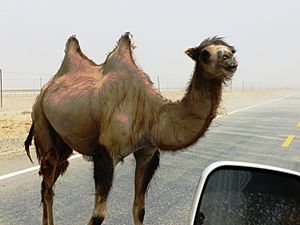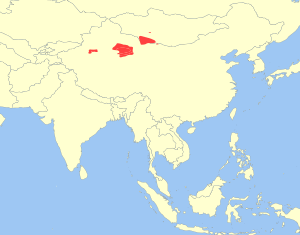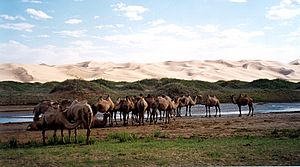Wild Bactrian camel facts for kids
Quick facts for kids Wild Bactrian Camel |
|
|---|---|
 |
|
| Wild Bactrian camel | |
| Conservation status | |
| Scientific classification | |
| Kingdom: | |
| Phylum: | |
| Class: | |
| Order: | |
| Family: | |
| Genus: | |
| Species: |
C. ferus
|
| Binomial name | |
| Camelus ferus Przewalski, 1878
|
|
 |
|
| Geographic range | |
The wild Bactrian camel (Camelus ferus) is a special type of camel that is in great danger of disappearing. It lives in parts of northern China and southern Mongolia. This camel is a close relative of the Bactrian camel (Camelus bactrianus), which is the kind of camel people have tamed.
Both types of camels are large animals with two humps. They are even-toed ungulates, meaning they walk on an even number of toes. They originally come from the dry, grassy plains (called steppes) of central Asia.
For a long time, people thought wild Bactrian camels were just regular Bactrian camels that had escaped and gone back to living in the wild. But new studies of their DNA show that they are actually a completely different species! They separated from the domesticated Bactrian camel about 1.1 million years ago.
Today, only about 1,000 wild Bactrian camels are left. Most of them live in a special protected area in China called the Lop Nur Wild Camel National Nature Reserve. A smaller group lives in Mongolia, in the Great Gobi A Strictly Protected Area. There are also other smaller groups in different nature reserves across China.
Contents
What's in a Name?
The two types of Bactrian camels, C. bactrianus and C. ferus, get their name from a place called Bactria. This was an ancient region in central Asia.
Camel Features
Wild Bactrian camels have special features that help them live in the desert. They have long, narrow nostrils that can close like slits. They also have two rows of long, thick eyelashes and hairy ears. All these features help protect them from desert sandstorms.
Their feet are tough and have two wide-spreading toes. A hard, horny layer on their feet helps them walk on rough, hot, and stony or sandy ground. Their body hair is thick and shaggy. It changes color to light brown or beige when winter comes.
Just like their domesticated relatives, wild Bactrian camels can eat snow to get water in winter. While it's a myth that camels store water in their humps, they are very good at saving water. However, if they go too long without water, they can get very sick.
How They Are Different from Domestic Camels
There are a few ways wild Bactrian camels look different from the camels people use. Wild Bactrian camels are a bit smaller. They are described as "lithe, and slender-legged, with very narrow feet." Their bodies also look flatter from the side.
Their humps are smaller, lower, and more cone-shaped than those of domestic camels. Sometimes, their humps are only half the size of a domesticated camel's humps. The wild Bactrian camel also has a flatter head. In Mongolia, their name havtagai means "flat-head." Their feet also have a different shape.
The wool of a wild Bactrian camel is always sandy colored. It is also shorter and not as thick as the wool of domestic Bactrian camels.
One amazing thing about wild Bactrian camels is that they can drink water that is saltier than seawater! It's believed that almost no other mammal in the world, not even the domestic Bactrian camel, can do this.
Camel Behavior and Life Cycle
Wild Bactrian camels usually travel in groups of up to 30 camels. However, groups of 6 to 20 are more common, depending on how much food is available. They move around a lot, covering wide areas. They often travel with one adult male leading the group. Larger groups can be seen near water sources.
These camels can live for about 40 years. They have their babies during winter, sometimes extending into the rainy season. Female camels start having babies when they are about 5 years old. After that, they usually have a baby every two years.
Where They Live and Their Home
Wild Bactrian camels live in dry plains and hills. Water is hard to find there, and there isn't much plant life. Shrubs are their main food source. The temperatures in these places change a lot. In summer, it can be as hot as 40–50 °C (104–122 °F), and in winter, it can drop to −30 °C (−22 °F).
Wild Bactrian camels travel long distances to find water. They look for springs near mountains or snow-covered hillsides that provide moisture in winter.
A herd can have up to 100 camels, but usually, groups have only 2 to 15 members. This is because of the dry environment and also because of illegal hunting.
Wild Bactrian camels are found in three main areas in northwest China and some parts of southwest Mongolia. In late 2018, China estimated there were about 600-650 camels in the Altun Shan-Lop Nur reserves. In Mongolia, there were about 800 camels in 2012.
Long ago, wild Bactrian camels lived in a much larger area, from the Yellow River in China all the way to the deserts of Inner Mongolia, Northwest China, and central Kazakhstan. By the 1800s, people hunted them for their meat and hides. Because of this, they were only found in very remote parts of the Taklamakan, Kumtag, and Gobi deserts in China and Mongolia. By the 1920s, only a few groups were left.
In 1964, China started testing nuclear weapons at Lop Nur, which was home to many wild Bactrian camels. The camels seemed fine and continued to have babies. The area became a restricted military zone, which meant fewer people were around to bother them. After China signed a treaty to stop nuclear tests in 1996, the wild Bactrian camels were officially listed as an endangered species.
Their Status and Threats
The wild Bactrian camel has been listed as Critically Endangered since 2002. This means they are at a very high risk of becoming extinct.
What Threatens Them?
Wild Bactrian camels face many dangers. The biggest threat is illegal hunting. People hunt them for their meat.
The only animals that regularly hunt wild Bactrian camels are gray wolves. Wolves often go after camels that are weaker or have been affected by bad weather. Because the desert is getting drier, more wolves are hunting camels near water sources.
See also
 In Spanish: Camello bactriano salvaje para niños
In Spanish: Camello bactriano salvaje para niños



